#Mahmud II
Text
La moschea Pertevniyal

La Moschea Pertevniyal, Pertevniyal Valide Sultan camii, venne fatta realizzare da Pertevniyal moglie del sultano riformatore Mahmud II e madre del sultano Abdülaziz. Pertevniyal é l’ultima Valide Sultan (Regina Madre) ad aver realizzato opere filantropiche come la fondazione di scuole, ospedali, istituzioni benefiche, fontane ed una moschea.
La moschea fu costruita tra il 1869 e il 1871 ed é opera dell’italiano Pietro Montani, pittore orientalista, architetto, mistico ed esoterista. Per molto tempo presidente della Società operaia di mutuo soccorso di Istanbul.
La moschea é molto interessante perché si presenta diversa dalle moschee classiche. Il suo design neogotico le conferisce una bellezza davvero distintiva.

Anche la porta del cortile della moschea è insolita per le moschee di Istanbul. Senza dubbio si tratta di uno dei rari prodotti dell'arte ottomana di scultura in pietra.


Non sono da meno la ricchezza delle decorazioni, fatte a mano, e che rendono interessante anche l’ambiente interno della moschea.



Durante la sistemazione di piazza Aksaray tra il 1956 e il 1959, alcuni elementi della moschea, come la fontana, sono stati rimossi o trasferiti altrove.
Istanbul per italiani é la tua guida turistica per Istanbul!
Organizziamo ESCURSIONI con GUIDE TURISTICHE UFFICIALI per chi vuole vivere e comprendere Istanbul. Percorsi speciali. Prezzi speciali. Adatti a tutti e con qualsiasi condizione meteo. Istanbul é una metropoli caotica e affollatissima ma é bellissima! Immergiti nella vita quotidiana di Istanbul e scoprila come non potresti mai fare da solo. Affidati a chi vive qui e conosce, respira e vive la metropoli sul Bosforo.
L’unica città al mondo che é su 2 continenti.
Realizziamo anche escursioni sul bellissimo lato asiatico di Istanbul! Ci sono tante cose da vedere!Ingressi ai musei senza file e senza problemi.Una esperienza diversa dal solito. Non per il turismo di massa e mercificato. Dal 2013 portiamo italiani in giro per Istanbul e li abbiamo resi felici.
Scopri la nostra offerta e scopri la differenza.
La mia Vita a Istanbul: consigli e informazioni turistiche. Disponibile come GUIDA per delle ESCURSIONI in città. Scrivi una e-mail a: istanbulperitaliani@gmail Seguici anche su www.facebook.com/istanbulperitaliani
2 notes
·
View notes
Text

#history#middle eastern history#ottoman#turkic#ottoman empire#military history#mahmud II#modern history#janissary#meme#funny
0 notes
Text



This blue and green kaftan was first worn by Şehzade Selim (later Sultan Selim II) in the fifth episode of the fourth season of Magnificent Century.
It is briefly seen again on Şehzade Mahmud in the first episode of the first season of Magnificent Century: Kösem. The kaftan is also worn by Şehzade Mustafa (later Sultan Mustafa I) in the twenty-first episode of the same season.
#Muhteşem Yüzyıl#Muhteşem Yüzyıl: Kösem#Magnificent Century#Magnificent Century Kösem#Magnificent Century Kosem#period drama#costume drama#historical drama#Selim II#Şehzade Selim#Sehzade Selim#Şehzade Selim (Son of Hürrem)#Şehzade Mahmud#Sehzade Mahmud#Şehzade Mahmud (Son of Halime)#Şehzade Mustafa#Mustafa I#Sehzade Mustafa#Şehzade Mustafa (Son of Halime)#reused costumes#recycled costumes
8 notes
·
View notes
Text










Royal Birthdays for today, August 2nd:
John Cicero, Elector of Brandenburg, 1455
Philippe II, Duke of Orléans, 1674
Mahmud I, Ottoman Sultan, 1696
Dietrich of Anhalt-Dessau, German Prince, 1702
Francisca of Brazil, Princess of Joinville, 1824
Emma of Waldeck and Pyrmont, Queen of the Netherlands, 1858
Constantine I, King of Greece, 1868
Ingeborg of Denmark, Duchess of Västergötland, 1878
Zein al-Sharaf, Queen of Jordan, 1916
Marie Gabrielle of Luxembourg, Countess of Holstein-Ledreborg, 1925
#john ii#philippe ii#mahmud i#Dietrich of Anhalt-Dessau#Emma of Waldeck and Pyrmont#constantine i#Zein al-Sharaf#royal birthdays#long live the queue#Ingeborg of Denmark#Marie Gabrielle of Luxembourg#Francisca of Brazil
7 notes
·
View notes
Text
Athener Kaffee-Tagebuch: Leoforos Nikis und Weißer Turm
Jetzt gilt es entlang der Leoforos Nikis am Meer zu flanieren. Der Boulevard beginnt als Fortsetzung der Navarchou Koundouriotou Pavlou an der Platia Eleftherias mit dem Shoa-Denkmal und führt in südöstlicher Richtung entlang der Küste vorbei an der Platia Aristotelous bis zum Weißen Turm, wo er in die Leoforos Megalou Alexandrou übergeht. Sie ist auch als Palea Paralia – Alte Uferpromenade –…
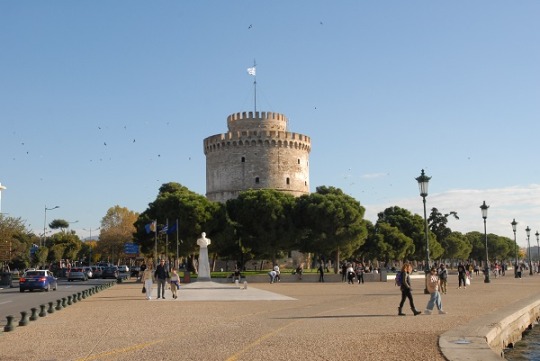
View On WordPress
#Achämeniden#Ägypten#Byzanz#Erzbischof Eustathios#Eustathios von Thessalonike#Konstantin I.#Leoforos Megalou Alexandrou#Leoforos Nikis#Mahmud II.#Palea Paralia#Philipp II.#Platia Aristotelous#Roter Turm#Süleyman der Prächtige#Sultan Murad II.#Thessalien#Thessaloniki#Weißer Turm
0 notes
Text

Brooch in the form of an eight-pointed star set with emeralds surrounded by border of brilliant-cut diamonds. Applied Ottoman tughra of Mahmud II in diamonds. In silver setting with gold pin and catch.
Presented to Queen Victoria by Mahmud II Sultan of the Ottoman Empire on the occasion of her coronation in 1838. Left to Princess Helena and later bequeathed to HM Queen Elizabeth II in 1967.
~ Royal Collection Trust
#queen victoria#jewel;brooch#source;royal collection trust#british royal family#thejewelcatalogue#queen elizabeth ii
88 notes
·
View notes
Text
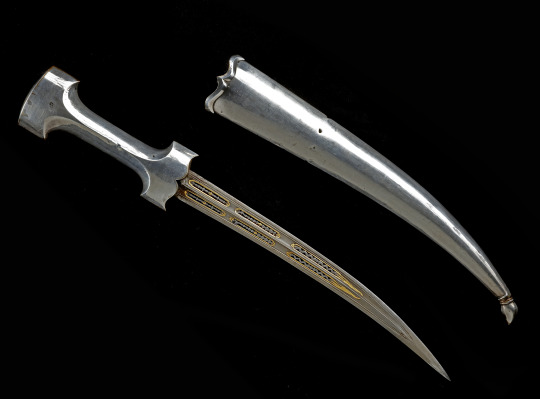

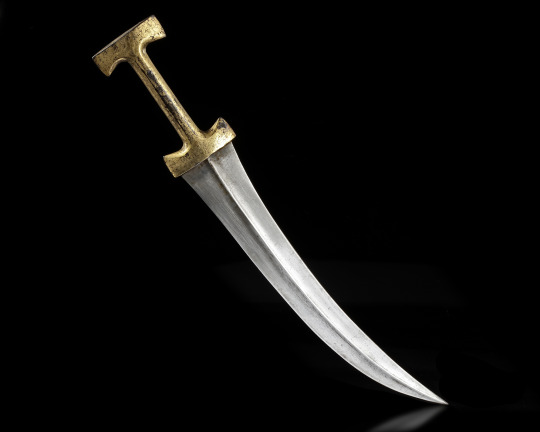

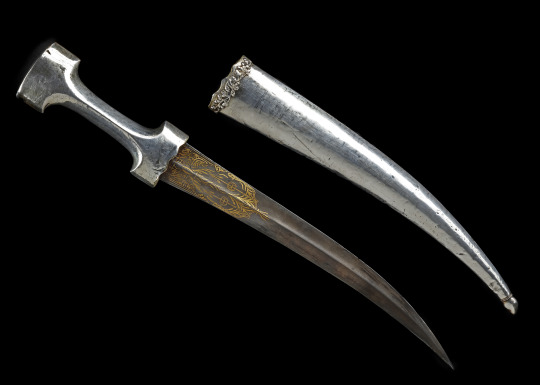

Ottoman daggers, 19th century
AN OTTOMAN SILVER DAGGER, (HANCER) TURKEY, 19TH CENTURY. Plain silver hilt with scalloped shoulder, with openwork to the blade, decorated in gold overlay. The plain silver scabbard marked with the tughra of Mahmud II 1223-55 AH/1808-39 AD. Length: 51 cm.
AN OTTOMAN DAGGER WITH TOMBAK HILT AND SCABBARD, TURKEY, 19TH CENTURY. The slightly edged double-edged watered steel blade with a raised central spine, the tombak waisted hilt of typical form engraved with leafy sprays and inscriptions ' Amal Ammar, work of Ammar'. The scabbard with tomabk chape and locket. Length: 47 cm. Width: 7 cm.
AN OTTOMAN SILVER DAGGER, (HANCER) TURKEY, 19TH CENTURY. Plain silver hilt with scalloped shoulder, the slightly curved blade with gold damascening decoration at forte. The plain silver scabbard with a grape-bearing vine frieze mount, marked with the tughra of Mahmud II 1223-55 AH/1808-39 AD. Lenght: 50 cm.
tinyurl.com/yh9fkh87
106 notes
·
View notes
Text
10 most Influential women in the Ottoman Empire (plus five non- sultans)
I must say in advance, this is purely my opinion and it doesn't include legal power,but general influence. For example if one woman had more legal power but still was limited to some actions, that another woman could get away with, I will rank her higher. Let's start with non sultans.
Part I: Non-Sultans
Number 5: Çevri kalfa

Çevri kalfa was a woman of Georgian origin and previously loyal servant to Nakşidili Sultan (also Georgian). She became mistress head treasurer( Baş hazindar usta) after accession of Mahmud II, who she saved from executioners by throwing them hot coals and sneaking the prince out. After becoming Head treasurer, she attained so much wealth that she could afford expensive clothes not even sultans wore. A girls school, built in her name, is one of the first schools for girls and the biggest primary school in Istanbul. She remained in her office until her death and was Sultan's trusted and favoured advisor.
Number 4: Meleki Kalfa
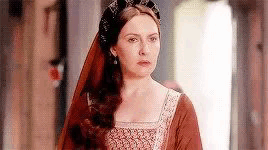
Meleki kalfa was a servant of Kösem and Ibrahim, however following the deposition of the sultan, she secretly switched sides as an agent of Turhan. Meleki played an important role in Turhan's rebellion by giving her information about Kösem's plan to dethrone Mehmed. After Kösem's death and Turhan's accession, she became an important person in Valide Sultan's court, was freed and married to Şaban Khalife. The couple built a residence in Istanbul, where Meleki not only conditioned her line of information to Turhan, but also acted as a negotiator in the palace on behalf of people. The political influence of her and her husband grew so much and they were murdered in 1656 for abuse of power.
Number 3: Gulfem Hatun

I have spoken about her in my previous posts
Number 2: Mahidevran Hatun
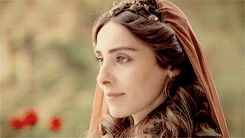
I have thought a lot about where to put her. People would expect her to be Number 1,mostly because they are used to her being sultan. That is what I first thought,for other reasons,but here we are. She has several significant influences that not many other women had:
1. She was popular with janissaries and people
2. Had a spy network, allowing her to hear major events happening in the capital.
3. She had strong allies. Ibrahim Paşa supported her and Mustafa later in his life, Hatice and her husband were supporting her openly or indirectly.
4. She was a considerable rival to the first and one of the most powerful women in the ottoman empire.
5. She had powerful characteristics: Was an intelligent, educated woman. Could mask her resentment towards Hürrem and act calmly around him.
6. She was a trusted advisor to her son. Actually, she supported the idea of Mustafa revolting against Suleiman,but only after she received information about his imminent execution, through her spy network.
Number 1: Çanfeda Kalfa

Çanfeda was the woman of Circassian origin, who served as second in command of Nurbanu for 18 years and the ruler of harem for another 11, so we can say she was de-facto Valide sultan.
In her almost three decades of service, she acquired wealth, so great that it attracted negative attention of Janissaries and even the grand Vizier. Although she collected such affluence through her salary(that was extraordinarily high consisting of 200 akches a day, it was the average salary of an imperial princess) and bribery, she used it for selfless purposes. She built three mosques, fountains, hamams, two schools, irrigation systems and fixed the roads, costing her several million akches, still she remained as one of the wealthiest people in the empire. In 1595, when Safiye exiled her, she needed dozens of carriages to carry her holdings, which apparently did not consist of much of the furniture, because she bought it from Venice the next year. It's also considerable that as an exiled person, she had to give up some of her wealth to imperial treasury.
Apart from her vital involvements in harem management in which she dominated Safiye, she had considerable influence over state matters as well. Çanfeda used her connections to install her not so bright brothers as paşas and after the series of mistakes,they were imprisoned, Çanfeda not only defied Grand viziers orders and had them set free,but restored them to their offices as well. Her power, wealth and influence came to the attention of Janissaries, who demanded her dead, but she got away with this as well. Another indication of her power, was her attempt to free the second son of sultan Murad. Even though she was caught red handed, the power it would take to infiltrate the prison is still considerable.
P.S. I did not list Halime and Handan,because after becoming Valide Sultans and regents they reached a whole different level, leagues above almost every single woman in ottoman history, however their power and influence was immense even when they were Hatuns.
As there is only 10 images/Gif limit. I will speak about 10 most powerful women in second posts.
#history#historical drama#16th century#magnificent century#magnificent century kosem#mc: kosem#medieval women#ottoman empire#ottomanladies#historical events#canfeda hatun#gulfem hatun#mahidevran hatun#mahidevran sultan#ottoman sultanas#ottoman history#ottoman#women in politics#sultanate of women#women in history#historical figures#historical#historyedit
83 notes
·
View notes
Text
The Calendar of Monte Cristo: Chapter 77
1808: Marriage of Ali Pasha of Tepelena and Vassiliki Kontaxi. [H]
1817: Birth of Haydée, daughter of Ali Pasha and Kyra Vassiliki. [R]
24 January 1822: Death of Ali Pasha. [H]
1822: Vassiliki and Haydée are sold into slavery and transported to Constantinople. Vassiliki dies at the end of the journey; Haydée is bought and educated.
c.1830: Haydée is sold to Sultan Mahmud II. [R]
183?: Haydée is bought from Sultan Mahmud II by the Count of Monte Cristo.
July 1838: After visiting Danglars, Albert continues on to visit the Count of Monte Cristo. The Count introduces him to Haydée and has her tell him her life story, with a few key omissions.
Although Haydée herself is fictional, her parents were real historical figures. Ali Pasha died more or less as the novel describes, allowing for dramatic licence. Vassiliki was taken to Constantinople as a prisoner, and lived until 1834, by which time Greece had won its independence and she had been allowed to return home.
If Ali Pasha and Kyra Vassiliki had any children together, I haven’t found any mention of them. Ali had three sons already when they married, the youngest of whom would have been around 15 years older than Haydée. All three were executed shortly after their father.
4 notes
·
View notes
Text
Giuseppe Donizetti — served Napoleon on Elba and accompanied him during the Hundred Days

Portrait of Giuseppe Donizetti later in life
Giuseppe Donizetti was born into poverty in 1788, in the Northern Italian city of Bergamo. The eldest of his siblings, he worked from a young age, training as a tailor’s apprentice. His true talent was in music, which was spotted early on in his life.
Giuseppe was conscripted in 1808 at the age of 20. He served the Napoleonic Kingdom of Italy in the Seventh Italian Regiment. He fought against Austria in the War of the 5th Coalition in 1809. He spent the years of 1811, 1812 and 1813 in Spain.
In 1811, he was became ill en route to Spain and was hospitalized at Castelnaudary in France. 43 years later in 1854, he wrote about it to the court of the Ottoman Empire:
“Constantinople, November 22, 1854. Mémoire to His Highness Achmed-Fethy Pasha. Finding myself in a comfortable position thanks to the beneficences of Our August and Glorious Sovereign, I cede to the Hospital of Castelnaudary (Aude), in which I was ill in 1811, the portion coming to me of the legacy left by the Emperor Napoleon I to the Battalion of the Island of Elba. The papers establishing my right to participate in the credit opened up by the Decree of August 5, 1854, issued at Biarritz by His Imperial Majesty the Emperor Napoleon III, I have been obliged to send to France at the time when I was honored with a brevet as Chevalier of the Legion of Honor. Your Highness's Very humble Servant, Joseph Donizetti.”
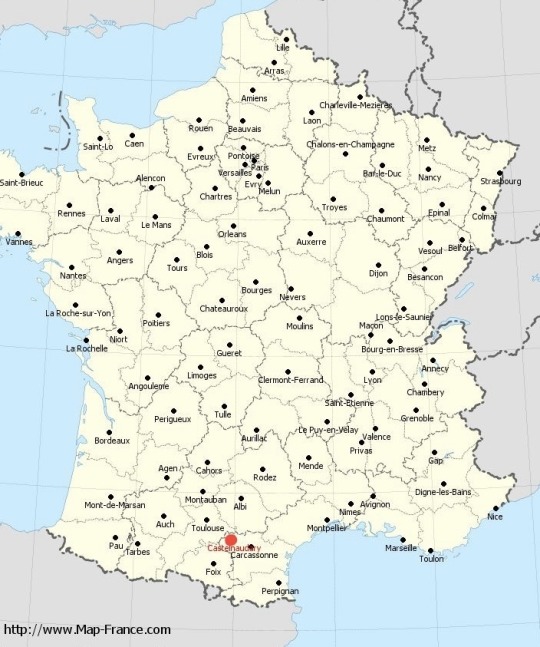

Location and photograph of Castelnaudary
After the dissolution of the Kingdom of Italy and the First French Empire, he enlisted in the French military and was stationed on the island of Elba as a military flutist. It was on Elba, in the town of Portoferraio, where he was married in 1815.
That same year, he accompanied Napoleon during the Hundred Days, traveling with him on the same ship from Elba to Antibes, France. He likely fought at the battle of Waterloo.
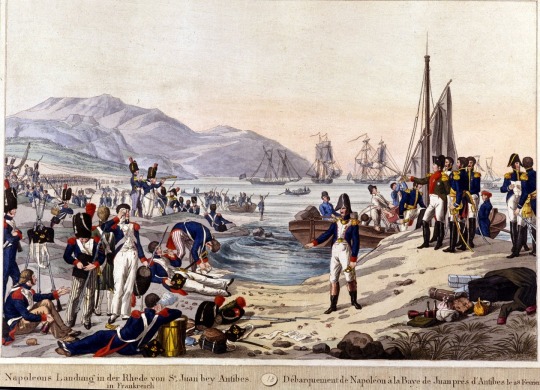
Landing of Napoleon I in Antibes in 1815
After Napoleon:
The Austrians took control of Northern Italy after the fall of Napoleon. According to the historian Emre Aracı, Giuseppe was “a greal admirer of Napoleon and the French […] Giuseppe strongly opposed his country’s domination by the Austrians. Evidence shows that he secretly took part in the Carbonari resistance and even appeared at court trials.”
Giuseppe Donizetti became a composer, and had a full career as Instructor General of the Imperial Ottoman Music. He even composed the first National Anthem of the Ottoman Empire, the Mecidiye Marşı. His main legacy is introducing Western marching music to the military of the Ottoman Empire.
He was employed by the Ottoman government on 17 September 1828 for an annual salary of 8,000 francs. This was considered a very high salary by his family. Giuseppe’s trouble with the Austrian authorities after the fall of Napoleon may have been a motivator for him to leave Italy. He moved to Constantinople at the age of 39 and spent the rest of his life there.
Giuseppe’s patron was Sultan Mahmud II, who ruled from 1808 to 1839, and Sultan Abdulmejid I, who ruled from 1839 to 1861.
According to the historian Emre Aracı:
“The Donizettis were so well-liked in the Ottoman capital that when fire broke out near their house Ahmet Fethi Pasha, the sultan's brother-in-law, ordered all the houses surrounding the maestro's home to be razed to the ground in order to prevent the flames reaching the building.”
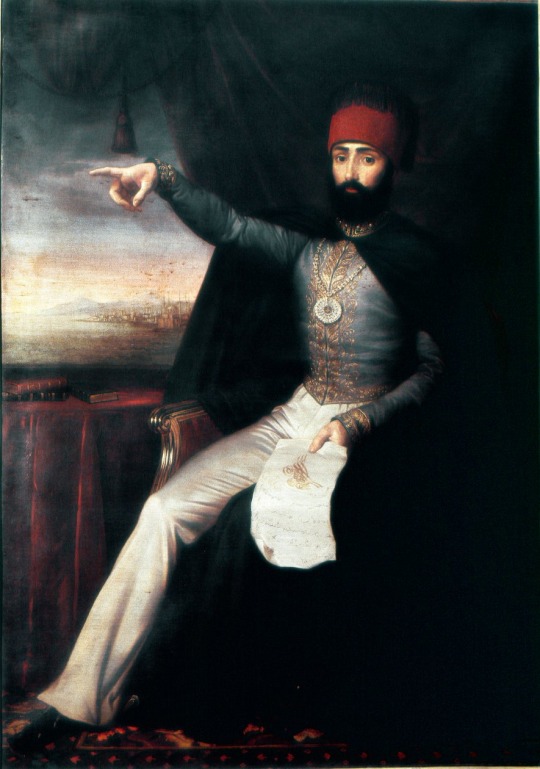
Sultan Mahmud II
His brother, Gaetano, called him his fratello turco— Turkish brother, writing to his friend that “He loves Constantinople, to which he owes everything.”
Giuseppe even encouraged his brother to move to Constantinople, but Gaetano declined. “I do not want to play the fool like my brother, the Bey, who, after having earned more than I perhaps, stays there in ancient Byzantium to scratch his belly between the plague and the stake,” wrote Gaetano.
Giuseppe moved to Constantinople two years after the creation of the Imperial Musical School (Muzıka-i Hümâyûn), which was an Ottoman institution which trained its students in Western style of music. He was specifically recruited as an expert to help lead this effort.

Giuseppe’s younger brother, Gaetano. By Francesco Coghetti, 1837
Gaetano Donizetti, though younger than Giuseppe, became the much more successful and internationally well-known brother, producing nearly 70 operas in his life. Gaetano is considered one of the most successful opera composers in history. Because of this, Giuseppe is widely known as Gaetano Donizetti’s brother. The historian Emre Aracı pointed out that this has actually been good for Giuseppe’s reputation because it has enabled him to be remembered when many other composers have been forgotten.
Both brothers were awarded the Ottoman Order of Nișan-i Iftihar. When Gaetano received the award at the Ottoman Embassy in Paris, he proudly said: “Napoleon belongs to two centuries, I to two religions.”
Burial:
Giuseppe died in 1856, and is buried in the vaults of St. Esprit Cathedral, on the European side of Constantinople, in the district called Pera (now called Beyoğlu). According to Emre Aracı, the district “was once the home of a thriving Christian community”. The Church was built in 1846, 10 years before Giuseppe died.
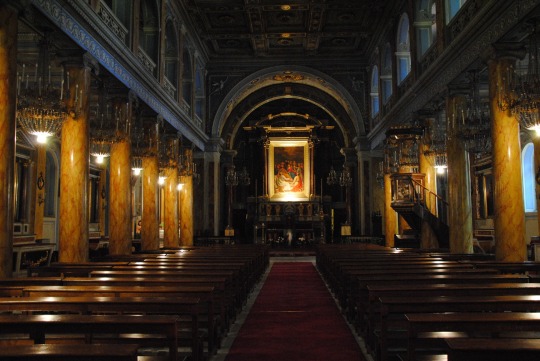
Interior of St. Esprit Cathedral
Giuseppe and his brother Gaetano are two great success stories and examples of people from impoverished backgrounds who go on to live prosperous and interesting lives.
Sources:
Herbert Weinstock, Donizetti and the World of Opera in Italy, Paris and Vienna in the First Half of the Nineteenth Century, 1963
Emre Aracı, Giuseppe Donizetti at the Ottoman Court: A Levantine Life, The Musical Times, Vol. 143, No. 1880 (Autumn, 2002), pp. 49-56
Emre Aracı, Giuseppe Donizetti Pasha and the Polyphonic Court Music of the Ottoman Empire, The Court Historian, Volume 7, 2 December 2002
Özgecan Karadağli, Western Performing Arts in the Late Ottoman Empire: Accommodation and Formation, 2020
#Giuseppe Donizetti#Donizetti#napoleonic era#napoleonic#Ottoman Empire#ottoman#napoleon#napoleon bonaparte#gaetano donizetti#turkey#turkish history#ottoman history#first french empire#French empire#history#19th century#france#french history#the hundred days#Francesco Coghetti#Istanbul#Constantinople#1800s#19th century history#Napoleon’s soldiers#opera#composers#composer
9 notes
·
View notes
Text






This green and brown coat was first worn by Şehzade Selim (later Sultan Selim II) in the twenty-ninth episode of the second season of Magnificent Century. It was worn again by Sultanzade Osman in the twentieth episode of the third season. The coat appeared twice in the fourth season, first on Şehzade Mustafa's son Mehmed in the eighteenth episode and then on Şehzade Bayezid's son Mahmud in the thirty-fourth episode.
It can also be seen on Sultanzade Selim in the sixth episode of the second season of Magnificent Century: Kösem.
The coat appeared again on an unnamed boy in the seventh episode of the second season of Tozkoparan İskender.
#Muhteşem Yüzyıl#Muhteşem Yüzyıl: Kösem#Magnificent Century#Magnificent Century Kösem#Magnificent Century Kosem#Tozkoparan İskender#period drama#costume drama#historical drama#Şehzade Selim#Sehzade Selim#Selim II#Şehzade Selim (Son of Hürrem)#Sultanzade Osman#Sultanzade Osman (Son of Hatice)#Şehzade Mehmed#Sehzade Mehmed#Şehzade Mehmed (Son of Mihrünnisa)#Şehzade Mahmud#Sehzade Mahmud#Şehzade Mahmud (Son of Şehzade Bayezid)#Sultanzade Selim#Unnamed Istanbul Citizens#reused costumes#recycled costumes
6 notes
·
View notes
Text
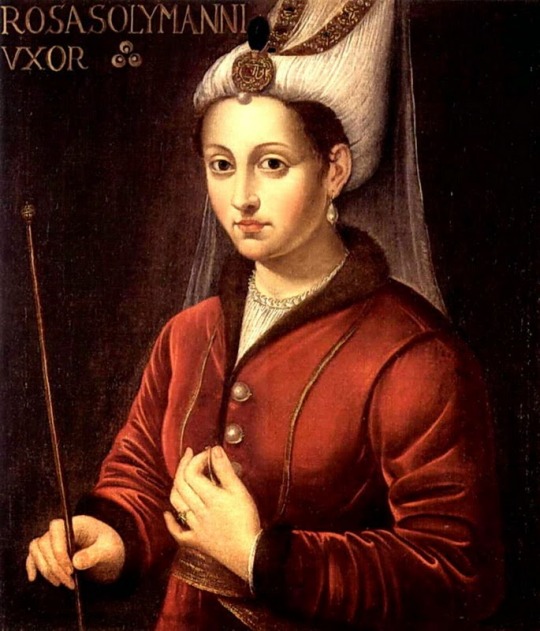

The other day I played the “Living People Related to Maria Theresa” game after a while, and remembered I once did that with Hurrem Sultan and thought I'd try it again, so here goes!
This is Roksan Kunter Özkan, she is a Turkish TV presenter, sports reporter, and media personality, and descends from Hurrem through her son Selim II. Supposedly her first name is derived from Roxelana, one of the names Hurrem was known by.
Roksan Kunter Özkan (Born August 10th, 1984) –> Ayten Sofia Nami Osmanoğlu –> Sultanzade Osman Nami Bey –> Ayşe Sultan –> Abdul Hamid II –> Abdulmejid I –> Mahmud II –> Abdul Hamid I –> Ahmed III –> Mehmed IV –> Ibrahim –> Ahmed I –> Mehmed III –> Murad III –> Selim II–> Hurrem Sultan
13 notes
·
View notes
Note
the mass killing of the iraqis by faisal i and ii of iraq and later, baathists were done with the knowledge and oftimes assistance of the uk, ussr, and/or usa. all three only started to really object to the misdeeds of iraqi rulers when saddam hussein decided to invade kuwait. are you too young to know what the mahmud barzanji revolts, 1st & 2nd iraqi-kurdish wars, and iran-iraq war were?
And what's your point, caller? Am I expected to list every group ever fucked over by the British empire before I can criticise current foreign policy? Do I have to preface every statement with the truth that I'm not a Ba'athist, that my father had to flee their regime and several of my family members were persecuted by them, just to appease you? Your exploitation of their suffering to score points is grim and evidence of some deep soulrot.
5 notes
·
View notes
Text
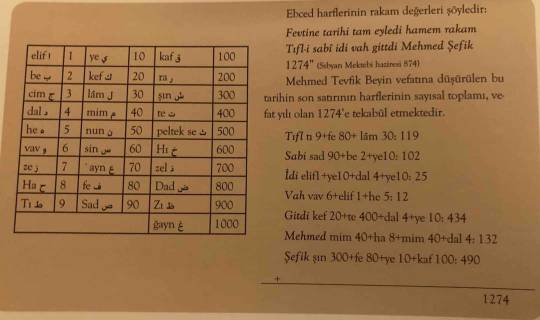
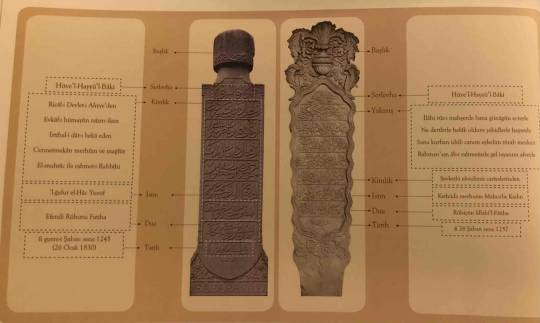


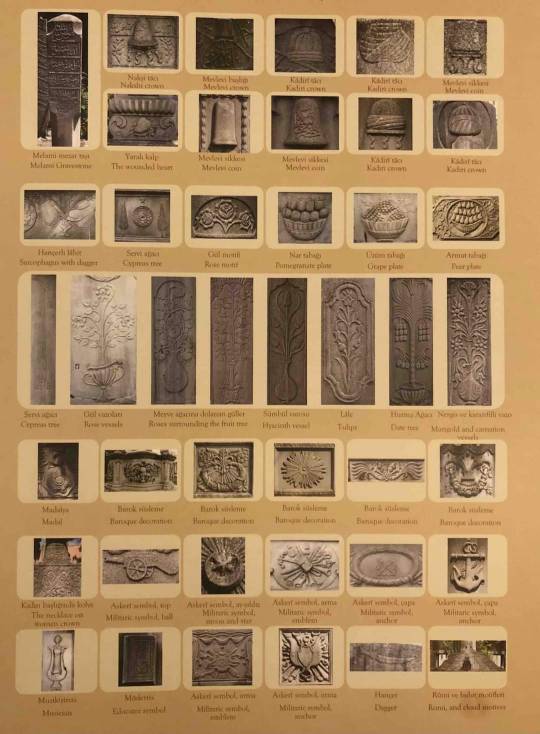
Mezar Taşlarında Başlık , Sembol ve Süslemeler
Kavuklar
Burma sanklı kavuk: XVI. ve XVII. asırlarda yoğun olarak görülen bu kavuk cinsine, padişah sandukalarında, sadrazam, vezirler ve üst seviye bürokrat kabirlerinde rasdanmaktadır.
Kallavi kavuk: Daha çok sadrazamların, vezirlerin ve üç ya da dört tuğlu paşaların taktığı kavuk türü olup 12 adet tespit edilmiştir. Gündelik hayatta yeri olmayan bu tören kavuklarının mezar taşlarında kullanımı tamamen semboliktir.
Mücevveze kavuk: Sarayda yüksek rütbelilerin tören kavuğu olan mücevveze kavak XVII. asırdan itibaren görülmektedir.
Örfi desarlı kavuk : Orta ve alt tabaka ulema tarafından kullanılan bu tür başlıklar zaman içinde yaygınlaşarak bir tarikata bağlı müridler tarafından kullanılır olmuştur.
Katibi Kavuk : Bu kavuk cinsini kullananlar hakkında kesin bir bilgi söylemek zordur. Ancak katiplerin kullandığı kavuk olarak maruf olduğundan katibi olarak adlandırılmıştır.
Fesler
1829 yılında Sultan II. Mahmud döneminde giyilmesi mecbur hale getirilen fes kırmızı renkli keçeden silindir şeklinde bir başlık türüdür. İlk olarak nerede kullanıldığı hakkında kesin bir şey söylemek zordur. Osmanlı’ya Fas’tan geldiği için fes adını alan bu başlık türü imal edildiği dönemin padişahının adına nispede Mahmüdi, Azizi, Mecidî veya Hamidi adlarını almaktadır. Fesin kenarında bir püskül sallanması da adettendi. Mahmudi ve onun devamı olarak da görebileceğimiz Mecidi fesin altı dar üstü genişçedir. Azizi fesin ise Mahmudi fesin tersine altı geniş üstü dar ve daha kısadır. Hamidi fes, yine alttan daha geniş ancak üstü azizi festen daha büyükçedir. Fes şapka kanunun kabul edildiği 1925 yılına kadar kullanılmıştır.
Fes her kesimden insanın kullandığı bir başlık türü olduğundan mezar taşları üzerinde yer alan feslere bakarak meslek veya sosyal sınıf ayrımı yapabilmek imkansızdır. Fesin kullanılmasıyla başlığa göre ortaya çıkan farklılıklar da kalkmış bulunmaktadır.
Tarikat Taçları
Tarikatlara ait başlıklar hazirelerde kendilerini hemen belli ederler. Mevlevilerin uzunca ve altta genişleyen başlığı bu gün en çok bilinen tarikat taçıdır. Mevlevi şeyhlerinin başlarında ise sikkenin alt kısmına dolanan destar görülmektedir. Bektaşilerin kullandığı on iki terkli Hüseynî ve dört terkli Edhemî taçlar da Mevlevi sikkeleri gibi ilk bakışta anlaşılabilirler. Diğer tarikat taçlarında ise başlığın üzerindeki dilim sayısı belirleyici olmaktadır.
Bayramîler altı terkli, Celvetiler ise on iki terkli başlık kullanmaktadırlar. Bunlardan başka Kadiri, Nakşî, Sünbuli gibi daha pek çok tarikat tacı mezar taşlarında başlık olarak yer almıştır. Melamiyye tarikatine mensub olanların mezar taşları diğer bütün taşlardan ayrı bir şekilde yapılmaktaydı.
Sembol ve Süslemeler
Ağaçlar
Hayat ağacı: Orta Asya kökenli bu ağaç en yaygın kullanılan ağaç motiflerinden biridir.
Servi ağacı: Elif harfi gibi uzun ve düz olduğundan vahdetin sembolüdür. Serviler rüzgarda sallanırken çıkardığı “Hu, Hu” sesiyle Allah’ı zikrettiğine inanılır. Yalnız Osmanlı’da değil hemen bütün Akdeniz kültürlerinde servi mezarlık ağacı olarak kullanılmıştır.
Hurma ağacı: Kabirde yatan kişinin hacı olduğuna işaret eder. Bol meyveleriyle canlılığı ve bereketi temsil eder.
Asma: Asma da tıpkı hurma ağacı gibi bolluk ve bereketi temsil eder.
Çiçekler
Lale: Ebced hesabıyla rakam değeri Allah ve hilal kelimeleriyle aynı olduğu için kutsiyetine inanılır.
Gül: Mezar taşlarında gerek şahide (baş) taşlarında gerekse ayak taşlarında ve başlıklarda sıkça kullanılan gül, Hz. Peygamber’in remzidir.
Sümbül: Halvetîliğin Sünbüliye kolunun sembolüdür.
Meyveler
Meyve sembolü ölümsüzlüktür. Zira dünya hayatının meyvesi ebedi cennet hayatıdır. Meyve geleceğin tohumunu da bünyesinde barındırır. Mezar taşlarında meyve tabağı içinde yer alan nar, armut, incir, üzüm erik kayısı ceviz limon hurma gibi meyveler hayat, bolluk ve bereketi temsil ederler. Bitkisel modflerin dışında kullanılan bazı sembolleri ise şöyle sıralayabiliriz:
Kandil: Anadolu mezar taşlarında çok görülen bu motif, mevtanın yolunu aydınlatıcı olarak düşünülmüştür.
Geometrik motifler: Kökü Orta Asya’ya bağlanan bu motifler kendi içlerinde sonsuzluk ve süreklilik gösterdikleri için Allah’ı hatırlatırlar
Hançer: Eyüpsultan’da birkaç örnekte gördüğümüz hançer motifi dünyayla ahireti birbirinden ayıran ölümü tasvir etmektedir. Eğer çocuk mezarları üzerinde görülürse bu genç yaşta hayattan ayrıldığını sembolize eder.
Osmanlı Devleti’nde özellikle XVIII. asnn sonu XIX. asrın başı itibariyle moda olan batı tarzı sanat anlayışı, kitap süsleme sanatından mimariye, musikiden mezar taşlarına kadar her alanda etkili olmuştur. Barok ve rokoko kıvrımlar, rumilerin, hatayilerin, geometrik süslemelerin yerini almıştır. Eyüpsultan da yaklaşık 450 seneye yayılan zaman diliminde mezar taşları görülebilir. Son iki yüz yılda daha fazla gömü yapılmasından dolayı son dönem baş tarzı süsleme anlayışı, Eyüpsultan hazirelerinin genel süsleme görüntüsünü oluşturmaktadır. Ancak bu süsleme anlayışı batıdan gelmişse de oradakilerin kuru bir taklidi olarak uygulanmamış, Osmanlı zevki içinde yoğrularak bu medeniyete has bir üslup kazanmışür.
20 notes
·
View notes
Text
Israel arrested men and stripped them naked
Updated:
3 hours ago
At least 100 Palestinian men detained by Israeli forces have been stripped to their underwear, blindfolded and made to kneel on a street in northern Gaza, according to images and videos widely circulated on social media and confirmed by the Israeli army.
The men were shown with their heads bowed as they were guarded by Israeli troops in the undated video that first surfaced on Thursday, which has drawn condemnation.
Al Jazeera’s Alan Fisher, reporting from occupied East Jerusalem, said on Friday that the images echoed the history of the region, where stripped men are taken to unknown locations.
LIVE
Open the menu
News
|
Israel-Palestine conflict
Palestinians detained by Israel in Gaza blindfolded, stripped to underwear
Hamas slams treatment of about 100 detainees as act of revenge and crime against defenceless civilians.
Israeli soldiers detain blindfolded Palestinian men
Israeli soldiers detain blindfolded Palestinian men [Mahmud Hams/AFP]
By Al Jazeera Staff
Published On 8 Dec 2023
8 Dec 2023
Updated:
3 hours ago
At least 100 Palestinian men detained by Israeli forces have been stripped to their underwear, blindfolded and made to kneel on a street in northern Gaza, according to images and videos widely circulated on social media and confirmed by the Israeli army.
The men were shown with their heads bowed as they were guarded by Israeli troops in the undated video that first surfaced on Thursday, which has drawn condemnation.
Al Jazeera’s Alan Fisher, reporting from occupied East Jerusalem, said on Friday that the images echoed the history of the region, where stripped men are taken to unknown locations.
KEEP READING
list of 4 items
list 1 of 4
Photos: Occupied West Bank faces growing Israeli aggression amid Gaza war
list 2 of 4
Israel arrests almost as many Palestinians as it has released during truce
list 3 of 4
The Take: With Israel’s release of prisoners, thousands more still detained
list 4 of 4
Finally free, Ubai was among the last Palestinian detainees Israel released
end of list
Advertisement
Many of the detainees were recognised by members of the community and family.
“Some say one was a student, one ran the local store and another one had no connection with ‘terrorism’ as he lived in an apartment block. … A number of people identified a well-known local journalist among those who were arrested,” according to Fisher, who added that one man was with his two children and all three of them were rounded up.
Shawan Jabarin, director of the Al-Haq human rights organisation, said he was “shocked” to see images that reminded him of the treatment of detainees and prisoners of war during World War II.
#palestine news#palestine#current events#palestina#justice for palestine#justice for palestinians#save palestine#save gaza#free palestine 🇵🇸#free palestine#free gaza#from the river to the sea palestine will be free
6 notes
·
View notes